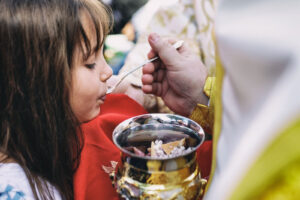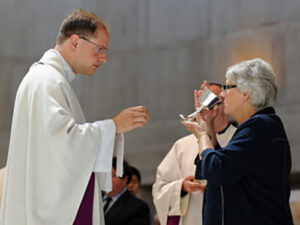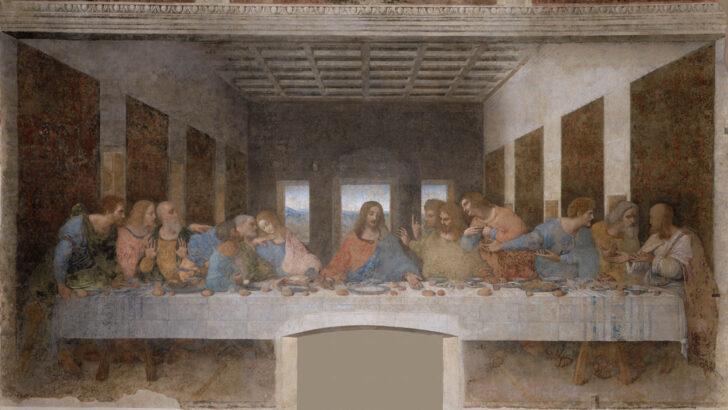Thomas O’Loughlin
This essay is a continuation of the theme of the essay on the breaking bread published here recently.
Whilst our common memory of the origin of the Eucharist is that Jesus took “bread and wine” (emphasising distinct materials), by contrast all our early texts notice that he shared “a cup” (the emphasis on how that drinking took place). Is this of any real significance? (1 Cor 10:16 and 21; 11:25, 26, 27 and 28; Mk 14:23; Mt 26:27; Lk 22:17 and 20; and Didache 9:2.)
The most obvious evidence that ‘a cup’ was significant in the Church’s memory was that having taken the cup, and blessed the Father, Jesus gave it to those at table so that they each drank “from it”.
It was not that they all drank wine – or any other liquid – which they could do from their individual cups, nor that they all had a drink of the same wine in that it came from one source, such as a flagon, but that they passed a cup from one to another and each drank from that same cup.
Just one cup? As a start, note just how unusual was this action of sharing a cup. There was no equivalent to it in any known Jewish practice. Making the sharing of a cup part of one’s table manners is confined exclusively to the followers of Jesus.
Here we have a practice unique to the Church. Indeed, so distinctive that its features of being ‘disruptive of expectations’ and ‘multiple attestation’ (Paul, the Synoptics, the Didache – and, as we shall see, possibly John) allows us to see an action that goes back to Jesus himself. (See JP. Meier, ‘The Eucharist at the Last Supper: did it happen?’ Theology Digest 42(1995)335-51.)
While drinking is a part of the meal rituals of all cultures, regularly passing a cup is rare. While we love to share meals, we want our own drinking vessels.
Only in emergencies (one canteen of water) or situations of exceptional informality (two friends, one beer, and no cup) will we share one container.
This human insight alerts us that, firstly, the widespread adoption of this action of sharing a cup cannot be dismissed as some minor detail. Secondly, we can see why virtually every Christian tradition has an unspoken aversion to it.

Significance
For Paul the choice facing those who share the cup is between “the cup of the Lord and the cup of demons. You cannot partake of the table of the Lord and the table of demons” (10:21).
This choice between the Christ and the demons was a choice that faced all Gentile disciples: were they willing to turn from the idols that were part of the social and domestic fabric of Greco-Roman urban life.
If one wanted to express the new discipleship then one not only turned from that which had been offered to idols, but one partook of the common cup of the disciples of the Christ.
Drinking from the common cup was a ‘boundary ritual’ that expressed commitment to discipleship, and as such was a serious matter and they will have to answer for their decision to drink from that common cup (11:27-8).
Since it is the action of declaring both commitment to discipleship and rejection of idols, it is a participation in the lifeblood of the Christ (10:16) and makes them part of the new covenant which was sealed in Christ’s blood (11:25).
Covenant
For Paul discipleship is about being part of the new covenant and sharing in the new life offered by the Christ; and taking the common cup – not a gesture done lightly – was accepting that discipleship and taking that lifeblood of the Christ into one’s own body.
We are accustomed to think of the act of Baptism as the boundary ritual of the new community, but for Paul at the time he first wrote to the Corinthians, the sharing of the cup was also a demarcation ritual – and since it was repeated weekly it was the on-going declaration of willingness to continue along the Way.
That such a paralleling of drinking the cup with Baptism was present in Paul’s mind when he wrote about that Church’s meals is confirmed by his remark about the Spirit being present in that Church: “For by one Spirit we were all baptised into one body – Jews or Greeks, slaves or free – and all were made to drink of one Spirit” (12:13).
Just as the Spirit united them in Baptism, so the Spirit was now what they drank in common. In short, if they wanted to be part of the new people, then they drank from the common cup accepting the consequences.
The assumption of the Didache is that those who are eating at the meal have already made a choice between the ‘Way of Life’ and the ‘Way of Death’; and it is explicit that only those who are baptised are to eat and drink (9:5) – so willingness to eat from the loaf and drink the one cup are marks of continuing commitment.
This relationship between Baptism and drinking as boundaries may seem strange to us who put these ‘sacraments’ into different theological compartments: one is about joining and a once-off event, while the other about continuing and is repeated over a lifetime.
Identity
However, such a neat system of ‘outcomes’ does not fit with how ritual establishes and maintains identity. One-off events need to be constantly recalled, while that which is an on-going concern needs to be seen to have a moment of establishment.

They were living as disciples – day-by-day facing its challenges – and so they declared themselves day-by-day while looking back to the moment when discipleship was established.
The two rituals, baptism and drinking the common cup need to be seen as complementary within living a life of commitment, rather than as distinct from one another with different functions in a theological system.
Looking at the Gospels we see that the one cup of the Lord is be taken as willingness to accept all that discipleship involves. The scene appears in Mk 10:35-40 where James and John, the sons of Zebedee, ask if they can sit beside Jesus in glory.
This prompts a challenge that links drinking the same cup as the Lord with Baptism: “Are you able to drink the cup that I drink, or be baptised with the Baptism that I am baptised with?” (10:38).
When they reply that they are able, they are told that “The cup that I drink you will drink; and with the Baptism with which I am baptised, you will be baptised” but that will not guarantee them their desired places. To be a disciple is both to share in the Baptism of Jesus and to drink the same cup as him.
In Mt 20:20-23 the story reappears but now the question is asked by their mother and the reference to Baptism has disappeared, but the message is just as stark: to be a disciple means drinking from the same cup that Jesus drinks – and this invites from the audience a ritual conversion. If you drink the ritual cup, then you consciously declare your readiness to accept the cost of discipleship.
This linking of the cup and discipleship is further developed in that Jesus’ own discipleship to the Father, presented as his willingness to drink the cup that the Father offers him. In both the Synoptics and John the suffering of the Father’s anointed must undergo is presented in terms of his ‘cup’ and Jesus’ willingness to drink it.
In Mk 14:36, followed closely by Mt 26:39 and Lk 22:42, this is presented as part of his prayer in the garden: “Abba, Father, … remove this cup from me; yet, not what I want, but what you want”. Thus with obedience he accepts where his discipleship has led. In Jn 18:11 Jesus does the Father’s will without hesitation, but again he is drinking ‘the cup’ that the Father has given him.
Acceptance
Drinking from one cup was an acceptance of a common communial destiny. As such it formed a very real, and possibly physically dangerous, boundary for them. It was also an act that shattered other boundaries such as those of race, social status, and factions within the churches, and implied a willingness for a new fictive community and a new intimacy in Jesus. Sharing a cup they had become blood brothers and sisters.
And today: does this call to drink from the one cup pose a challenge to contemporary Christian practice? It could be argued that sharing the cup is now common in many communities – though Catholics still find it most unusual.
Our hesitations to sharing a vessel that touches our lips are deep-seated. The Orthodox Churches, for example, use a spoon – which destroys the gesture’s force. Some Protestant Churches use individual thimble-sized glasses that are as destructive of Jesus’ bold symbolism as pre-cut Catholic wafers destroy the original loaf symbolism, while both transmit signals that appeal to an individualistic consumerist culture.
Powerful
The fact that most Christians try to avoid sharing the cup is a powerful reminder that discipleship involves hard choices: discipleship costs!
“Examine yourselves, and only then eat of the loaf and drink of the cup” (1 Cor 11:28). Can we face the common cup of shared covenant discipleship?
***
Partaking of the bread and wine in different Christian cultures and traditions
Comment by the Books Editor
Increasingly in Ireland in recent decades, inter-church encounters, travel abroad, television and the internet have made Irish Catholics more familiar with the customs and traditions of Christianity as a whole.
We have become more accommodating in our ideas about others, now that so many nationalities live in our cities and towns and their children attend our schools, altering our very ideas of what it means to both Irish and Catholic.
We are no longer surprised that fellow Christian do things differently than we have done here in the past.


 The Last Supper as imagined by Leonardo da Vinci – an image far removed from the historical reality.
The Last Supper as imagined by Leonardo da Vinci – an image far removed from the historical reality. 